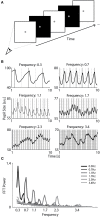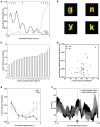Tracking the allocation of attention using human pupillary oscillations
- PMID: 24368904
- PMCID: PMC3857913
- DOI: 10.3389/fpsyg.2013.00919
Tracking the allocation of attention using human pupillary oscillations
Abstract
The muscles that control the pupil are richly innervated by the autonomic nervous system. While there are central pathways that drive pupil dilations in relation to arousal, there is no anatomical evidence that cortical centers involved with visual selective attention innervate the pupil. In this study, we show that such connections must exist. Specifically, we demonstrate a novel Pupil Frequency Tagging (PFT) method, where oscillatory changes in stimulus brightness over time are mirrored by pupil constrictions and dilations. We find that the luminance-induced pupil oscillations are enhanced when covert attention is directed to the flicker stimulus and when targets are correctly detected in an attentional tracking task. These results suggest that the amplitudes of pupil responses closely follow the allocation of focal visual attention and the encoding of stimuli. PFT provides a new opportunity to study top-down visual attention itself as well as identifying the pathways and mechanisms that support this unexpected phenomenon.
Keywords: PFT; SSVEP; attention; attentional blink; frequency tagging; oscillations; pupil; tracking.
Figures







Comment in
-
Pupillometry: the eyes shed fresh light on the mind.Curr Biol. 2014 Mar 31;24(7):R281-2. doi: 10.1016/j.cub.2014.02.028. Curr Biol. 2014. PMID: 24698378
References
-
- Alexandridis E., Manner M. (1977). Frequency of the pupillary response following flicker stimuli (author's transl). Albrecht Von Graefes Arch. Klin. Exp. Ophthalmol. 202, 175–180 - PubMed
-
- Andreassi J. L. (2000). Pupillary response and behavior, in Psychophysiology: Human Behavior and Physiological Response, ed Andreassi J. L. (Mahwah, NJ: Lawrence Erlbaum Assoc; ), 218–233
-
- Averbach E., Coriell A. (1961). Short-term memory in vision. Bell Sys. Tech. J. 40, 309–328 10.1002/j.1538-7305.1961.tb03987.x - DOI
LinkOut - more resources
Full Text Sources
Other Literature Sources

